| Author |
Message |
|
Gabriele Becattini
|
 Posted: Fri 14 Dec, 2012 4:57 am Post subject: sword at the royal armoury leeds Posted: Fri 14 Dec, 2012 4:57 am Post subject: sword at the royal armoury leeds |
 |
|
Hi,
i would like to know if someone can provide a full photo of the sword depicted near the jack of plates located at the royal armoury in leeds, or may be pointing me toward a website or link with some photos, or even show me other swords with a similar hilt arrangement (knuckle bow and one or two siderings)
thank you very much
 Attachment: 193.27 KB Attachment: 193.27 KB

|
|
  |
 |
|
E.B. Erickson
Industry Professional
|
 Posted: Sat 15 Dec, 2012 2:22 am Post subject: Posted: Sat 15 Dec, 2012 2:22 am Post subject: |
 |
|
That sword (or a very similar one) is shown in Wilkinson's "Sword and Daggers". This book is long out of print, but maybe someone here that has a copy can scan the photo for you.
There's a photo of an excavated example in the booklet " Arms and Armour in Tudor and Stuart London", published by the London Museum. I have a copy of this on hand, and I'll scan the page and post it here on Monday.
--ElJay
|
|
   |
 |
|
Gabriele Becattini
|
 Posted: Sat 15 Dec, 2012 5:30 am Post subject: Posted: Sat 15 Dec, 2012 5:30 am Post subject: |
 |
|
|
Thank you Mr.Erickson, i really appreciate your help!
|
|
  |
 |
Randall Moffett

|
 Posted: Sat 15 Dec, 2012 4:27 pm Post subject: Posted: Sat 15 Dec, 2012 4:27 pm Post subject: |
 |
|
Sadly i just checked my RA folder and found I have 7 photos of the jack but none have a full sword shot. Sorry. It is a lovely sword from what I remember.
I just had grand schemes of making the jack but never got to it but have loads of photos for planning.
RPM
|
|
  |
 |
|
E.B. Erickson
Industry Professional
|
 Posted: Mon 17 Dec, 2012 12:57 am Post subject: Posted: Mon 17 Dec, 2012 12:57 am Post subject: |
 |
|
Here's the promised photos. They used this sword as a model to introduce hilt nomenclature, and so I've included the drawing of the hilt along with the photo. It show some details that aren't visible in the photograph.
The pommels have holes in them, apparently for a sword knot, but what I don't know is if the pommels are solid or hollow.
--ElJay
 Attachment: 86.14 KB Attachment: 86.14 KB
[ Download ]
 Attachment: 200.69 KB Attachment: 200.69 KB
[ Download ]
|
|
   |
 |
|
Neil Melville
|
 Posted: Mon 17 Dec, 2012 4:03 am Post subject: Posted: Mon 17 Dec, 2012 4:03 am Post subject: |
 |
|
And here, thanks to Mr Erickson's hint, is the actual sword in the Royal Armouries. I have Wilkinson's book but didn't realise that it had a photo of the sword you wanted until he suggested it.
Ciao,
Neil
 Attachment: 112.64 KB Attachment: 112.64 KB

N Melville
|
|
  |
 |
|
Radovan Geist
|
 Posted: Mon 17 Dec, 2012 6:47 am Post subject: Posted: Mon 17 Dec, 2012 6:47 am Post subject: |
 |
|
that sword depicted in Wilkinson´s book has an iinterestingconstructions. side-plates / shells ddefinitelydo not fit with the ricasso on the blade. Could it be a composite, as Wilkinson suggests?
I have seen couple of similar swords on Hermann Historica - they either have those side-rings and ricasso, and are considered as an early type of rapier (late 16th century), or have plates / shells, but no ricasso, and no lower rings, and are called riding swords / campaign swords (1620s-1630s).
Does the one in Leeds have those plates / shells?
|
|
  |
 |
|
Gabriele Becattini
|
 Posted: Mon 17 Dec, 2012 7:18 am Post subject: Posted: Mon 17 Dec, 2012 7:18 am Post subject: |
 |
|
thanks to everybody for the wonderful photos and text explaination, i was wondering if this kind of sword was peculiar to england in the late XVIth century it remind to me to some italian or spanish model but usually the hilt was more complex,
assuming that the pierced plates inside the rings are a later addiction, it is curious to see the finger rings not matched by a sidering,
also if i remember correctly i have seen in an older topic a very similar sword but unfortunately i have not been able to find it, (if i'm not wrong the author should have been Sean Flynt, so if Sean is reading this toipic...)
|
|
  |
 |
|
E.B. Erickson
Industry Professional
|
 Posted: Tue 18 Dec, 2012 1:27 am Post subject: Posted: Tue 18 Dec, 2012 1:27 am Post subject: |
 |
|
I think that the shells on the RA sword are later additions, because if you compare the RA sword with the excavated example, you'll note that the blades are virtually identical, yet the excavated sword doesn't have the shells, and doesn't have any indication that it ever had shells.
Given the similarity of the RA and the excavated sword, I have wondered if we're looking at a military sword "pattern". Pattern is in quotes because this is obviously way before anyone was designing swords dictated by government patterns. However, in England, those responsible for raising regiments would go to a specific cutler and have him make up a group of similar swords with which to arm the troops. Are these swords relics of a particular regiment?
While one can find essentially similar hilts from Europe, these hilts with the lack of lower rings and the "bite" out of the quillons are an English style. Interestingly, this quillon treatment is also seen on some English baskethilts of the 15-1600s, and the London Museum has a largish left hand dagger with these quillons as well ( I just remembered: I think that Claude Blair's book, "European and American Arms" has a photo of the dagger). The dagger also has a pommel shape that matches that of the sword that's the subject of this thread: was the dagger made to match a sword like this? Were they perhaps sold as a set?
Interesting questions!
--ElJay
|
|
   |
 |
Glennan Carnie

|
 Posted: Tue 18 Dec, 2012 5:13 am Post subject: Posted: Tue 18 Dec, 2012 5:13 am Post subject: |
 |
|
I have long believed the 16th Century saw the emergence of artefacts such as weapons being made to popular 'styles' or 'patterns'.
From a commercial perspective it makes sense - if a particular style is popular then, as a maker, why would you not make things that people want to buy? Just as with today, the popular styles would have been made in different qualities - finely made for those that could afford it; cheap-and-nasty knock-offs for those that wanted the popular look but couldn't afford it.
We know clothing and shoes were made this way; and even gravestones. There is nothing to suggest weapons were not made in this fashion, too.
For example, the basket-hilt swords found on the Mary Rose, at Southwark Bridge, the River Cam sword and the other examples in the Royal Armouries all share remarkably similar characteristics, without being identical. Another example: almost (if not) all the bollock daggers found on the Mary Rose were of the same style, that style matching an example in Leeds.
I doubt this points to there being only one maker of a particular style; rather, given the fact that the extant artefacts represent a very small sample of all the items made, this would suggest a lot of makers fabricating items in the same style.
I can easily imagine 16th Century quartermasters purchasing swords in the same style but of differing qualities, to equip troops. To the lay observer it would present a uniform image without resorting to spending vast sums on high-end weapons. We know purchasers loathed spending any more money than was absolutely necessary.
|
|
  |
 |
Sean Flynt

|
|
   |
 |
|
Gabriele Becattini
|
 Posted: Tue 18 Dec, 2012 9:23 am Post subject: Posted: Tue 18 Dec, 2012 9:23 am Post subject: |
 |
|
the hilt configuration make sense for a military use of the sword, where fingering the ricasso could not have been essential, or absolutely not necessary if wearing an armoured gauntlet, it could be interesting to see it in practice but the degree of protection offered to the hand, should be considerable in spite of the semplicistic design, the more elaborate specimen posted by Sean is really interesting, a later developpement or near contemporay?
the same style of sword is depicted in a couple fencing manuals from germany and france, plus i have seen a fresco depicting a dueling scene fought in the 1560s by two italian nobleman with the same style of sword and clearly not fingering the ricasso, in every case only one ring is visible so i can only speculate about a simmetry and no other element of protection are visible, but this style of sword was probably widespread in various countries and not only for military use
|
|
  |
 |
|
Gabriele Becattini
|
 Posted: Wed 19 Jun, 2013 2:19 am Post subject: Posted: Wed 19 Jun, 2013 2:19 am Post subject: |
 |
|
any other exaple of this kind of hilt around?
i'm more and more interested in such kind of simple military hilt from the late XVIth century,
|
|
  |
 |
|
|

